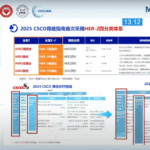
The 2024 European Society for Medical Oncology (ESMO) Annual Meeting was held in Barcelona, Spain. A Phase III randomized controlled trial (SYLT-021), led by Dr. Rongbo Lin’s team from the Department of Gastrointestinal Oncology, Fujian Cancer Hospital, was selected as one of six Proffered Paper oral presentations in the palliative care session. This study compared hydromorphone intravenous patient-controlled analgesia (IPCA) with oral morphine for severe cancer pain management.To provide deeper insights into this research and its potential impact on cancer pain management, Oncology Frontier spoke with Dr. Cheng Huang and Dr. Rongbo Lin from Fujian Cancer Hospital.
Oncology Frontier: Dr. Lin, could you introduce the background and key findings of this study? What is its significance for cancer pain management?
Dr. Rongbo Lin: The Phase III SYLT-021 trial was conducted across 48 research centers in China, comparing hydromorphone intravenous patient-controlled analgesia (IPCA) with oral morphine for severe cancer pain after successful titration. The study examined two IPCA methods: self-administered bolus-only (BO) dosing and background infusion combined with bolus (CIRD), evaluating their effectiveness against oral morphine maintenance therapy.
The results demonstrated that IV IPCA hydromorphone significantly reduced the three-day average pain score (3DNRS) compared to oral morphine, while also achieving higher patient satisfaction. Additionally, BO-IPCA (without background infusion) was not inferior to CIRD-IPCA (with background infusion), and it required less opioid consumption, leading to fewer side effects.
The findings from SYLT-021 could have a major impact on traditional WHO three-step pain relief guidelines. Historically, the WHO model prioritizes oral administration, but our study suggests that for severe cancer pain, IV IPCA is superior to oral opioids. Moreover, while WHO guidelines recommend scheduled dosing, our findings indicate that as-needed dosing is also an effective approach.
With aging populations and rising cancer incidence worldwide, the demand for effective pain management has increased. At the same time, concerns about opioid misuse continue to grow. The SYLT-021 study provides new treatment options for cancer pain, offering more flexibility in opioid administration and potentially improving patient outcomes.
Oncology Frontier: How did different administration methods of hydromorphone (CIRD vs. BO) compare in terms of safety? Did IV IPCA increase the risk of adverse effects compared to oral morphine? How do these findings impact patient safety?
Dr. Rongbo Lin: At this year’s ESMO conference, our Phase III study not only confirmed the efficacy of hydromorphone IPCA in cancer pain management, but also addressed an important clinical question: is as-needed dosing as effective as scheduled dosing? Although WHO guidelines recommend scheduled opioid administration, there is limited evidence supporting its superiority over as-needed dosing. In fact, some studies suggest that as-needed dosing can reduce opioid consumption while maintaining the same level of pain relief.
Our study is the first in the world to demonstrate that as-needed dosing is not inferior to scheduled dosing. We found that patients using as-needed IPCA required significantly lower doses of hydromorphone compared to those on scheduled dosing, while also experiencing fewer side effects.
This finding has important clinical implications. It suggests that future pain management strategies should consider as-needed dosing as a viable alternative. Additionally, the use of IV IPCA allows patients to self-administer pain relief, eliminating delays in pain management and ultimately improving quality of life.
Given these benefits, we advocate for the clinical adoption of IV IPCA, as it enables individualized pain control based on a patient’s real-time needs. This personalized pain management approach could become an important direction for future cancer pain treatment.
Oncology Frontier: Based on these findings, Dr. Huang, what are the future research directions for cancer pain management? How do you envision the clinical application of hydromorphone IPCA? Are there plans for long-term follow-up studies?
Dr. Cheng Huang: At the 2024 ESMO conference, our team presented this study in the Proffered Paper LBA session of the palliative care track, focusing on whether patients should switch to oral opioids after successful titration or continue IV hydromorphone IPCA. This research attracted significant international attention and sparked extensive discussions at the meeting.
This study, which took 3–4 years to complete, was a nationwide, multicenter trial involving over 30 centers in China and more than 1,400 patients. The primary objective was to determine whether patients should transition to oral opioids or continue IV IPCA after successful titration. This research is highly significant both in China and internationally, gaining recognition from global experts and being selected for oral presentation at ESMO.
The findings will have a profound impact on cancer pain management in China and could lead to updates in international guidelines. It challenges traditional three-step pain management strategies and offers a more effective approach for severe and refractory cancer pain. The ability to rapidly titrate pain control and transition to oral treatment allows for more personalized pain management, improving clinical outcomes.
Future research in cancer pain management should focus on several key areas. First, while 80% of patients achieve effective pain relief using the three-step WHO model, approximately 20% still experience severe or refractory pain. Personalized approaches, such as IPCA, could provide better pain control for these patients, further optimizing pain relief strategies.
Second, with aging populations and increasing cancer rates, more patients require palliative care and end-of-life support. Pain management plays a crucial role in this field. Advancements in home-based pain management and palliative care research could improve quality of life for patients and drive opioid policy changes in China.
Third, novel pain relief formulations—such as transdermal patches and alternative delivery methods—are expanding treatment options. Oral hydromorphone formulations may offer a sustainable solution for long-term pain management after successful PCA titration.
Finally, telemedicine and artificial intelligence (AI) applications in pain management will enhance patient care by facilitating remote monitoring and personalized treatment adjustments. The development of smart pain management systems could further improve treatment precision. Additionally, hydromorphone IPCA, which allows for continuous IV titration followed by oral conversion, will play a significant role in future cancer pain management strategies.
With continued research and collaboration, we believe that China’s cancer pain management practices—including clinical applications and policy development—will continue to evolve, ultimately benefiting more patients worldwide.


